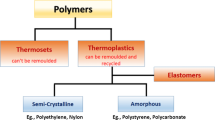Abstract
The structure of nine commercially manufactured aluminum-containing adjuvants was investigated by X-ray diffraction, infrared spectroscopy, transmission electron micrography, and energy dispersive spectrometry. Seven samples which were labeled as aluminum hydroxide were identified as boehmite, a crystalline aluminum oxyhydroxide [AIO(OH)]. However, the degree of crystallinity varied between the samples. Two samples which were labeled as aluminum phosphate were found to be amorphous aluminum hydroxyphosphate. Buffer anions and sulfate anions substitute for hydroxyls in the amorphous aluminum hydroxide formed by the in situ alum precipitation method. Finally, the aluminum-containing adjuvant in diphtheria and tetanus toxoid, U.S.P., produced by three manufacturers was characterized.
Similar content being viewed by others
REFEREBCES
A. T. Glenny, C. G. Pope, H. Waddington, and U. Wallace. The antigenic value of toxoid precipitated by potassium alum. J. Pathol. Bacteriol. 29:31–40 (1926).
R. Edelman. Vaccine adjuvants. Rev. Infect. Dis. 2:370–383 (1980).
C. Hannoun. Vaccines against influenza. In A. Voller and I. Haenzel (eds.), New Trends and Developments in Vaccines, MTP Press, London, 1978, p. 65.
J. Kreuter and I. Haenzel. Mode of action of immunological adjuvants: Some physiochemical factors influencing the effectivity of polyacrylic adjuvants. Infect. Immun. 19:667–675 (1978).
P. Souza Santos, A. Vallejo-Freire, J. Parsons, and J. H. L. Watson. The structure of Schmidt's aluminum hydroxide gel. Experientia 14:318–320 (1958).
D. D. Perrin, B. Dempsey, and A. Albert. Buffers for pH and Metal Ion Control, Chapman and Hall, London, 1974.
The United States Pharmacopeia, 21st rev., United States Pharmacopeial Convention, Rockville, MD, 1985, p. 30.
N. J. Kerkhof, R. K. Vanderlaan, J. L. White, and S. L. Hem. pH-stat titration of aluminum hydroxide gel. J. Pharm. Sci. 66:1528–1533 (1977).
H. P. Klug and L. E. Alexander. X-Ray Diffraction Procedures for Polycrystalline and Amorphous Materials, 2nd ed., Wiley, New York, 1974, pp. 694–700.
R. Tettenhorst and D. A. Hofmann. Crystal chemistry of boehmite. Clays Clay Min. 28:373–380 (1980).
P. H. Hsu and J. B. Dixon. Minerals in Soil Environments, Soil Science Society of America, Madison, WI, 1977.
G. W. Brindley and G. Brown. Crystal Structures of Clay Minerals and Their X-Ray Identification, Mineralogical Society, London, 1980, pp. 364, 365.
P. Souza Santos, A. Vallejo-Freire, and H. L. Souza Santos. Electron microscope studies on the aging of amorphous colloidal aluminum hydroxide. Kolloid Z. 133:101–107 (1953).
P. A. Buining, C. Pathmamanoharan, M. Bosboom, J. B. H. Jansen, and H. N. W. Lekkerkerer. Effect of hydrothermal conditions on the morphology of colloidal boehmite particles: Implications for fibril formation and monodispersity. J. Am. Ceram. Soc., 73:2385–2390 (1990).
C. J. Serna, J. L. White, and S. L. Hem. Anion-aluminum hydroxide gel interactions. Soil Sci. Soc. Am. J. 41:1009–1013 (1977).
C. J. Serna, J. C. Lyons, J. L. White, and S. L. Hem. Stabilization of aluminum hydroxide by specifically adsorbed carbonate. J. Pharm. Sci. 72:769–771 (1983).
M. K. Wang, J. L. White, and S. L. Hem. Influence of acetate, oxalate and citrate anions on precipitation of aluminum hydroxide. Clays Clay Min. 31:65–68 (1983).
J. C. Liu, J. R. Feldkamp, J. L. White, and S. L. Hem. Adsorption of phosphate by aluminum hydroxycarbonate. J. Pharm. Sci. 73:1355–1358 (1984).
S. L. Nail, J. L. White, and S. L. Hem. Structure of aluminum hydroxide gel. II. Aging mechanism. J. Pharm. Sci. 65:1192–1195 (1976).
Y. I. Ryskin and V. C. Farmer. The Infrared Spectra of Minerals, Mineralogical Society, London, 1974, p. 137.
S. L. Nail, J. L. White, and S. L. Hem. Comparison of IR spectroscopic analysis and X-ray diffraction of aluminum hydroxide gel. J. Pharm. Sci. 64:1166–1169 (1975).
T. T. P. Cheung, K. W. Willcox, M. P. McDaniel, and M. M. Johnson. The structure of coprecipitated alumino-phosphate catalyst supports. J. Catal. 102:10–20 (1986).
Author information
Authors and Affiliations
Rights and permissions
About this article
Cite this article
Shirodkar, S., Hutchinson, R.L., Perry, D.L. et al. Aluminum Compounds Used as Adjuvants in Vaccines. Pharm Res 7, 1282–1288 (1990). https://doi.org/10.1023/A:1015994006859
Issue Date:
DOI: https://doi.org/10.1023/A:1015994006859




